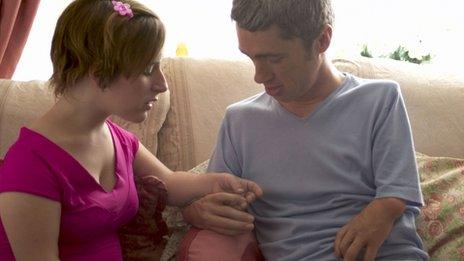What's happened to Thalidomide babies?
- Published
- comments

Fifty years ago, the sedative Thalidomide was withdrawn after thousands of mothers gave birth to disabled babies. That ageing Thalidomide generation now faces rising care bills - but some hope a possible Nazi link to the drug could bring more compensation.
In November 1961, I was five months old. My family had no idea why their otherwise healthy baby boy had been born with short arms, twisted hands and no thumbs.
But by the end of that month, the truth was finally out in the open.
After a German newspaper reported that Thalidomide was the likely cause for the mysterious spate of disabled babies born in Germany since 1958, the drug's producer, Chemie Gruenenthal, caved in to growing pressure, and on 26 November withdrew all products containing Thalidomide from what had been very lucrative, over-the-counter sales.
A few days later, Thalidomide's British licensee, Distillers, followed suit in the UK. But by then, the damage was done.
Thalidomide has strong sedative properties and many women in the early weeks of pregnancy had taken it to ease their morning sickness, utterly unaware its effect on the unborn child can be teratogenic, or "monster-forming".
Limbs can fail to develop properly, in some cases also eyes, ears and internal organs. No-one knows how many miscarriages the drug caused, but it's estimated that, in Germany alone, 10,000 babies were born affected by Thalidomide. Many were too damaged to survive for long.
Today, fewer than 3,000 are still alive. In Britain, it's about 470. Among the nearly 50 countries affected are Japan (approximately 300 survivors), Canada and Sweden (both more than 100), and Australia (45). Spain's government only recently acknowledged the drug was ever distributed there. No-one knows how many Spanish survivors there are. It could be hundreds.
After 1961, the drug didn't disappear - medical researchers discovered it can be extremely effective in certain treatments. Stringent precautions should be taken, particularly with women patients of child-bearing age. But sadly, in Brazil, where the drug has been widely used in treating certain leprosy symptoms, there is now another, younger generation of disabled Thalidomide survivors.
Just as the drug's effect in the womb seems totally random, so too was the compensation received. In recent years, UK survivors have won concessions from the government, the tax authorities and Distillers' successor company, which has boosted current average compensation pay-outs in the UK to around $63,000 (£40,000) a year.
But elsewhere, survivors still get nothing, or very little. Of today's 6,000 estimated survivors around the world, nearly half fall under the compensation deal in Germany. That currently provides a yearly maximum of about 13,500 euros (£11,840), which does not cover the needs of those with multiple limb deficiencies. Many have no independent income and require constant care.
Campaigns for higher compensation are gaining support - in Germany and elsewhere. Progress has been slow, but that could change dramatically, if proof is found that it was not Chemie Gruenenthal which discovered Thalidomide, as has always been claimed, but scientists working for the Nazi regime.
Gruenenthal patented Thalidomide in the mid-1950s. But investigations in the past two years have confirmed that the German brand-name - Contergan - was owned by the French pharma-company, Rhone-Poulenc, during the early 1940s, when it was effectively under Nazi control.
It's also now becoming clear that Gruenenthal was part of a post-war network of German scientists and businessmen who had played leading roles during the Nazi era. Immediately after the war, for example, Gruenenthal employed Dr Heinrich Mueckter as chief scientist, who was sought in Poland on charges of war crimes after conducting medical experiments in prison camps, during which hundreds of prisoners may have died.

The severity of the condition varies
"Gruenenthal taking on someone like Dr Mueckter is one of the key factors we must highlight in the Thalidomide scandal," says Gernot Stracke, a leading spokesman for survivors in Germany.
He adds: "To my knowledge, no representative for the German government has yet made any public comments about Thalidomide's possible roots in the Nazi-era, or whether the government would accept greater liability and offer more help to survivors if proof of such a link were found."
Martin Johnson, director of the UK Thalidomide Trust, and Professor Ray Stokes, of the University of Glasgow, are preparing to publish a book after investigating Thalidomide's possible Nazi origins.
Mr Johnson says: "Although, at this stage, we cannot prove that Thalidomide was definitely developed and tested in prison camps by the Nazis, there is overwhelming circumstantial evidence that it was tested as part of their search for an antidote to nerve gas."
For the survivors, decades of coping with stunted, twisted or missing limbs has meant greater wear and tear on remaining joints and muscles, and virtually guaranteed the premature onset of arthritis and chronic pain.
Many who managed to go out and work have already been forced into early retirement, while others who used to rely on their parents for everyday care, can no longer do so. Every year, more and more are becoming totally dependent on other family members, on social benefits or health insurance payouts - or on charity.
Which is why, on 26 November - 50 years on - we, the German survivors, will march, waddle, limp or roll in wheelchairs from the Brandenburg Gate to the Federal Chancellery in Berlin.
To celebrate that we are still alive, and to remember those who never lived.